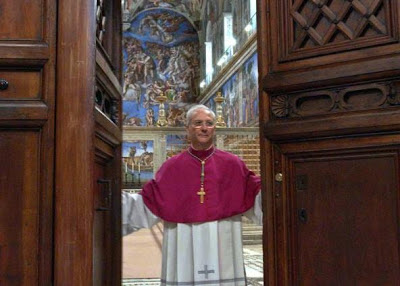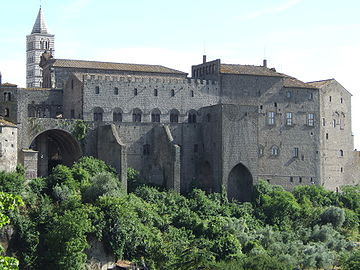 |
| Modern bronze copy of the Augustus of Prima Porta, Via dei Fori Imperiali,
© Alice Barigelli
|
I love anniversaries and meaningful dates, and this year has been full of them. Back in February we
commemorated the 450th anniversary of the death of the great
Michelangelo, in April we celebrated the 450th birthday of
Shakespeare and remembered the 300th anniversary of the passing of
El Greco. This year has also seen important anniversaries of events that have
changed history, from the toppling of the Berlin Wall (25 years ago), to the passing
of the Civil Rights Act (50 years ago), to D-Day (70 years ago), to the opening
of the Panama Canal and onset of World War One (both 100 years ago).
But the most awe-inspiring and
moment-of-silence-worthy of all, particularly for those of us who love big,
round numbers (and happen to live and breathe ancient Roman history), is the
2000th anniversary of the death of Emperor Augustus.
 |
| Detail of the Augustus of Labicana, Museo Nazionale Romano a Palazzo Massimo (source) |
Exactly 2000 years
ago today, on 19 August A.D. 14, Emperor Augustus, born Gaius Octavius and the
first emperor of Rome, breathed his last. Throughout his long life, Octavius
wore many hats, and carried many titles. He was known as Princeps (the “first”
citizen of Rome), Divi Filius (the son of the divine, in reference to his
great-uncle and adopted father, the deified Julius Caesar), Augustus
(illustrious one), Pater Patriae (father of his country), and, of course,
Caesar, a family name that would eventually become synonymous with the term
“emperor.” His official roles were just as varied, from Consul (Rome’s highest
elected office) to Pontifex Maximus (high priest) and eventually Imperator
(military commander).
During his 41-year reign (the
longest of any Roman emperor), Augustus built enduring monuments, developed the
city’s infrastructure, and established the Pax Romana, the empire’s most
enduring period of peace. If you’re in Rome today and have nothing more
important to do (and really, in the middle of August, what else could you
possibly have to do?), I suggest commemorating the extraordinary man’s death
with a tour of his greatest monuments and portraits.
 |
| Ara Pacis (source) |
The best way to appreciate
Augustus’s footprint on the fabric of his city is to take a tour of the works
he built. He was credited with the line, “I inherited Rome a city of brick; I
left it a city of marble,” and whether or not he actually said it, the words certainly
ring true. Perhaps the most recognizable of the monuments in his legacy is the
Ara Pacis (Lungotevere in Augusta). Although the first years of his
reign were marred by war, Augustus’s dedication to restoring peace to the
empire was what set him apart from the leaders who would follow him. The
majestic white marble Altar of Peace was inaugurated in 9 BC to celebrate the
peace brought to the empire by Augustus’s military victories in Hispania and
Gaul. Although partially reconstructed, the altar nevertheless possesses much
of its original bas-relief decoration, depicting Roman myths, scenes of ritual
sacrifice, intricate garlands, and a procession of Augustus and other members
of the imperial family.
 |
| Ara Pacis illuminated (source) |
Despite the modern misconception that ancient Rome was a city of gleaming white marble, in actual fact, Roman marble buildings were generally painted in bright vibrant colors, and this was certainly the case with the Ara Pacis. In honor of this big anniversary, the exquisite monument will be illuminated with colored laser beams to recreate what it most likely looked like in the emperor's day. This is not the first time this technique has been used (see my post: Real Rome: The Ara Pacis in Technicolor), but it is always spectacular to behold. You can visit tonight from 9pm to midnight without a reservation.
.JPG) |
| Il Viaggio nel Foro di Augusto, © Andrea Franceschini, courtesy of Zetema Group |
In the heart of the Imperial Fora,
found partially excavated alongside right and left of Via dei Fori Imperiali,
the Forum of Augustus was the physical representation of Augustus’s power.
The forum incorporates the Temple of Mars Ultor (the avenging god of war) and
was at the time considered “greater than any in existence.” While not completed
until 2 BC, the temple was first planned by Augustus after he successfully
avenged Caesar, killing his assassins Brutus and Cassius in 42 BC. Just in time
for the big anniversary, the forum comes to life in a summer-long project that
helps visitors experience the site as it once was.
.JPG) |
| Il Viaggio nel Foro di Augusto,
© Andrea Franceschini, courtesy of Zetema Group
|
Every night, a digital
multi-media show recreates the original appearance of the forum before your
very eyes. Audience members are provided with earphones with audio in six
languages, while the images and animation are projected directly onto the walls
of the forum. Visit www.viaggionelforodiaugusto.it
for more details.
 |
| Interior of the House of Augustus, Palatine Hill (source) |
Unlike the emperors who would
succeed him, Augustus lived not in an opulent palace but a comfortable,
tasteful home. He chose to live on the Palatine Hill (as would his successors)
to underline his connection to Romulus and Remus, the twin founders of Rome who
were raised, according to legend, on the very same hill seven centuries
earlier, and where Augustus himself was born. Despite its relatively small
size, the House of Augustus is celebrated for its superb second-style
Pompeian frescoes in vibrant red, black, yellow, purple, and green. See the
glorious and well-preserved works in several rooms, including the mysterious
Room of the Masks and Augustus’s own study, an intimate haven he called
“Siracusa.” When visiting the Palatine Hill, keep in mind that this particular
site is only open Mon, Wed, Thu, Sat, and Sun, from
8:30am to 1:30pm. (It’s always a good idea to call and double check if it’s
open: 060608.)
 |
| Mausoleum of Augustus (source) |
Built in 28 BC, the Mausoleum of
Augustus (Piazza Augusto Imperatore) is perhaps the most neglected of
Rome’s ancient sights. Over the centuries, it has been the victim of cannon
fire, earthquake, abandonment, and vandalism, and during its long life has been
used as a fortress, a bullring, and a concert hall. But thanks to sturdy
defensive walls, some 15 feet thick and 50 feet tall, the site has survived
against all odds. Although the mausoleum has been closed for decades, this year’s
milestone has been the impetus for the city to pledge €12 million to its
restoration and eventual reopening. Although this site is *never* open, it is
today! To commemorate this once-in-a-millennium anniversary, the city of Rome
is opening the mausoleum for three guided tours this morning. I’ll be there at
9:30, and documenting my visit on Twitter (if I’m allowed to take photographs,
that is). If you see this in time, call 060608 and you might just be in time to
join one of the groups.
 |
| Theater of Marcellus (source) |
A few other sites that shouldn’t be
missed and are all within walking distance of one another: the Theater of
Marcellus (Via del Teatro Marcello), an imposing performing arts center and
the second-largest theater in ancient Rome, was built by Augustus in 13 BC and
is crowned by a still-inhabited palace built in the Renaissance. (All month
long, the theater’s purpose is revived with classical musical performances
staged just outside the towering structure. Check out www.tempietto.it for a full list of
performances.) The Portico of Octavia (Via di Portico d’Ottavia) is
another Augustean site, once a vast cultural and religious center, although
sadly little survives today beyond its entrance gate, which is currently hidden
under a dreary layer of scaffolding. The Obelisk of Montecitorio (Piazza
Montecitorio) (originally from Heliopolis and dating to the 6th century
BC) was brought from Egypt to Rome by the emperor in 10 BC to be used as the
pointer of his massive sundial that spread across the Campus Martius
neighborhood. The 70-foot monolith cast a shadow across the Ara Pacis on
Augustus’s birthday (23 September), a not-so-subtle hint that he was born to
bring peace to the empire.
 | |
| Augustus of Prima Porta, Musei Vaticani, Source: Wiki Commons |
Get to know the man up close by
studying one (or more) of his many portraits, located in museums across the
city. By far the most famous is the Augustus of Prima Porta. This
larger-than-life-sized marble sculpture depicting Augustus in the role of
imperator, or military commander, was discovered in 1863 in the ruins of the
Villa of Livia, in an area that was once countryside and is now on the northern
outskirts of the city. The commanding work now has its residence in the Braccio
Nuovo section of the Vatican Museums (Viale Vaticano).
 |
| Bust of the Divine Augustus, Musei Vaticani, © Nick Thompson |
Also displayed at
the Vatican, in the welcoming Pinecone Courtyard, is an enormous posthumous
portrait of the Divine Augustus, discovered in the 16th
century on the Aventine Hill. Another celebrated portrait is the Augustus of
Via Labicana. Located today at the National Roman Museum at Palazzo Massimo
(Largo di Villa Peretti, 1), this moving work represents a togaed Augustus in
his role as Pontifex Maximus, Rome’s spiritual leader. The Hall of the Emperors
at the Capitoline Museums (Piazza del Campidoglio, 1) displays the Ottaviano
Capitolino, an important early bust of Augustus, showing him as a
determined, ambitious, yet vulnerable young man. But you don’t have to visit a
museum to find a portrait of Rome’s favorite leader. A modern bronze copy of
the Prima Porta statue stands in front of Augustus’s forum along Via dei Fori
Imperiali.
 | |
| Ottaviano Capitolino, Capitoline Museums, Source: Wiki Commons |
“If I have
played my part well, clap your hands and dismiss me with applause from the
stage.”
—Augustus’s
last words













